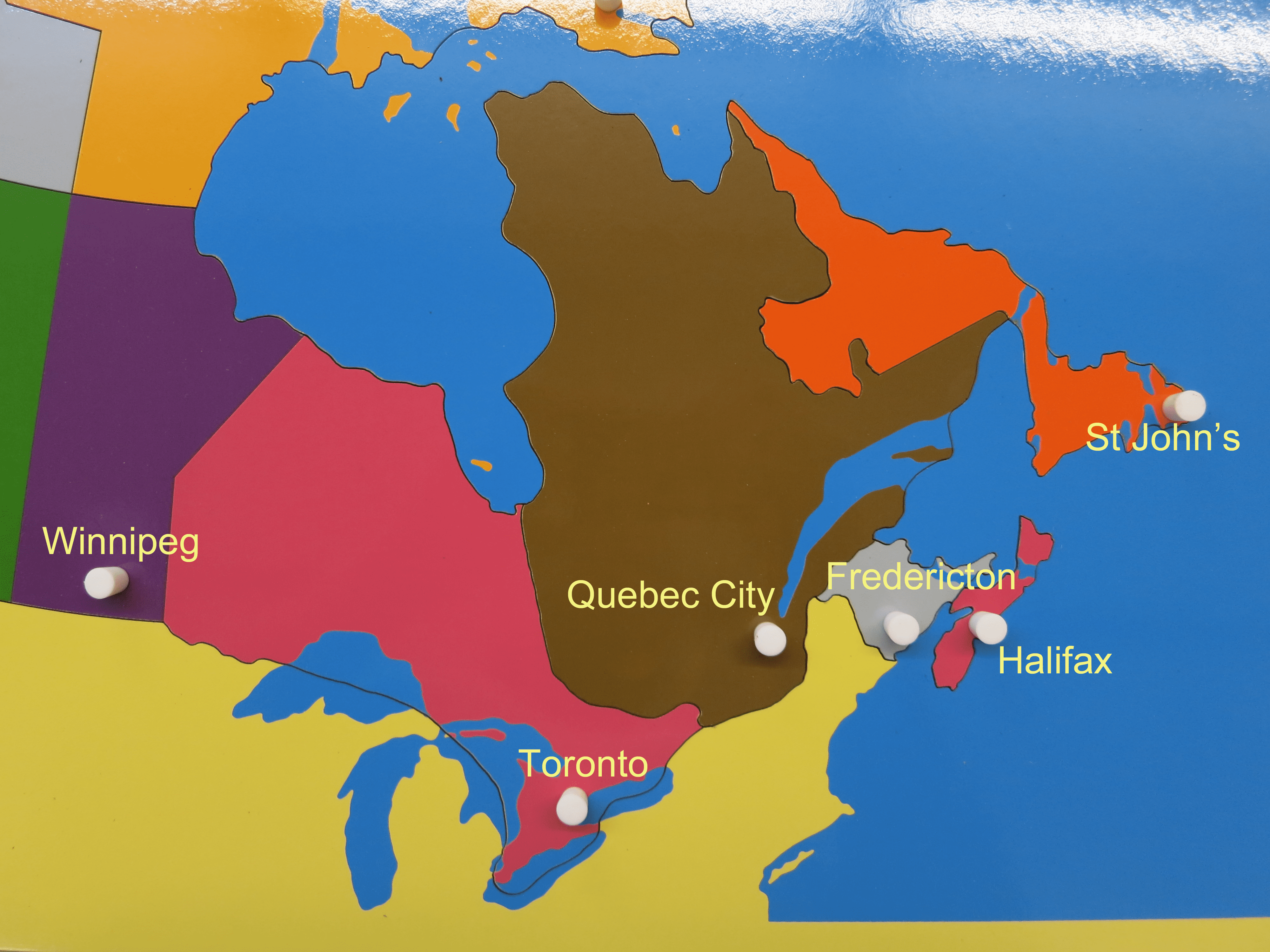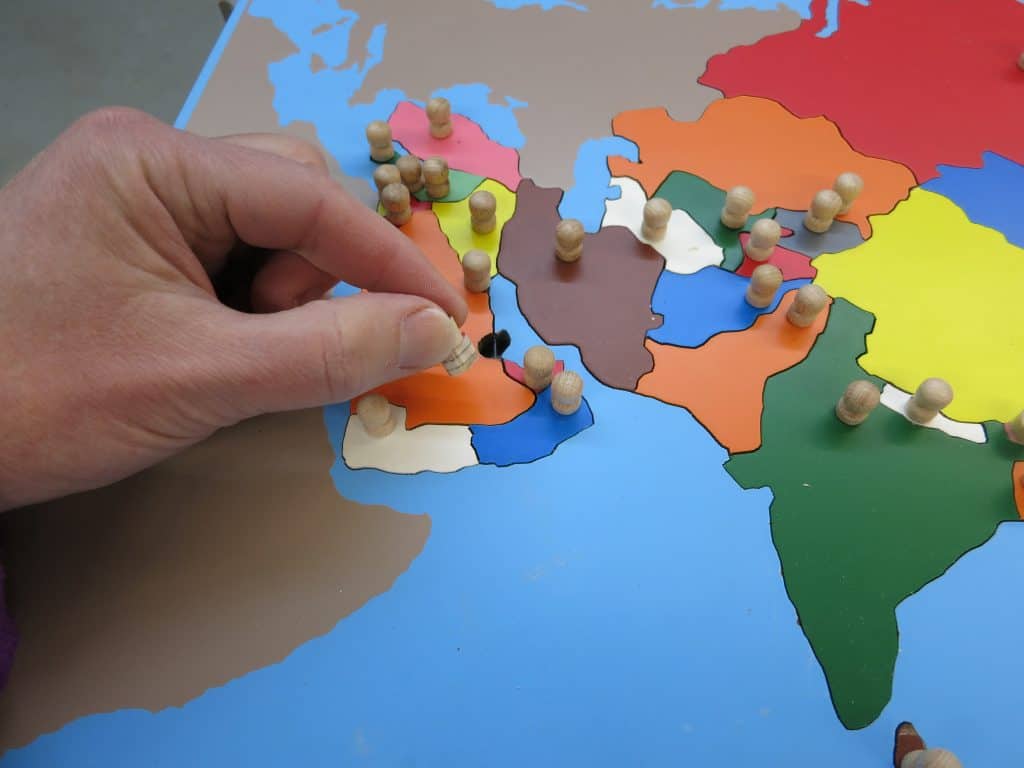The Emphasis of Puzzles in the Montessori Classroom
When you think about it, there is probably no other educational philosophy that places such emphasis on the use of puzzles in the classroom. In fact, in Montessori schools puzzles are not just in the classroom as random activities that children can take out when there is a quiet moment, as a way to occupy a child if they are done their work early, or as a way to appease a child who needs some redirection. Puzzles are the curriculum.
History of Jigsaw Puzzles
As you may guess, puzzles have been around for a long, long time. They are one of those quintessential toys (if you want to call it that) that never seem to die. Are they a toy, a game, a mind bender or an educational activity? The truth is, puzzles can be all of those things. The market for puzzles has exploded. You can find everything from the basic good old flat square or rectangular cardboard versions, to shaped puzzles, to complicated wooden ones with perplexing shapes, to foam pieces that create 3D sculptures, and many more in between.
The very first puzzles are credited to a British map engraver named John Spilsbury in the mid 1700’s. He came up with the idea to mount images of maps on wood and cutting out the countries around their borders with a scroll saw. His intention with these “dissected maps” was to help children learn geography.
People caught on to the idea and soon puzzles were being created with pastoral and religious images, farm animals and nursery rhymes. And so it goes from there.
Puzzles Develop the Brain
If you missed the blog post on 4 Ways Puzzles Exercise Your Brain, you can read that here. There is so much research you can easily Google about why doing puzzles are good for you. From the neurological standpoint, developing fine motor skills, spatial awareness and hand eye coordination, to the social aspects like teamwork, goal setting and perseverance.
But aside from all of that well documented research, what is it about the Montessori curriculum that makes puzzle activities so effective in the classroom?
Maria Montessori Saw the Value of Puzzles
By Maria Montessori’s era in the early 1900’s both adults and children were enjoying doing all kinds of puzzles. Undoubtedly she could see the educational value of this activity.
As with the entire Montessori curriculum and philosophy, all the educational elements are related to one another and puzzle work is no exception.
Puzzles for Montessori Infant Programs
Montessori education for infants begins with one piece puzzles at about 9-10 months roughly, depending on the child. The easiest of this type of puzzle is a selection of 3 shapes – a circle, a triangle and a square. Each shape has a large, easy to grasp knob. These shapes are introduced one at a time, in isolation of each other. They are available as single puzzle blocks of one shape, or a rectangular board with all three shapes.
Puzzles with Knobs
It is important to use shape puzzles with knobs. This is to help begin building the finger muscles to develop the pincer grasp. You may see single shape puzzles for sale with no knobs, which are often handmade wooden toys. Although beautiful, if they lack a knob, they are missing this crucial building block and only serve to reinforce crude grasping, cupping and scooping actions.
Shapes Puzzles
The circle is usually introduced first as it is the easiest to place. Once that shape has been mastered the square is next and the triangle last. Each shape is learned individually and put away while the next shape is explored. This progression may happen between 10-12 months.
Between 12-14 months, again child dependent, once the shapes are well understood the child can move to the rectangular board with all three shapes together. Or perhaps a board with 3-5 shapes by around 18 months.
Differences in a Montessori Classroom
The difference between a non Montessori classroom and one using a Montessori curriculum with respect to these initial puzzles, for example, is that they are methodically introduced to each child. Each child progresses at their own pace to work with the next puzzle shape. If it becomes apparent that they have not quite learned the previous shape, then it can be reintroduced and reinforced.
A different type of preschool classroom may have a shelf of “age appropriate” puzzles that children can take out and work with themselves. There may not be any particular teaching involved for each puzzle. They are treated more as toys. The difference in a Montessori classroom is that the Montessori Guide (aka “teacher”) works with the children individually. The guide helps them understand the shape and what they are looking at, as well as modelling and correcting the pincer grasp.
Another important point with respect to Montessori materials, or “toys” as they are sometimes referred to in the marketplace, is that they are not toys. They may look like colourful blocks and puzzles, but their purposes are very well defined and structured in the pedagogy. When shopping for “Montessori inspired” materials for the home, one must realize that the simple act of the child playing with these materials does not equate to learning in a Montessori way. However, you do not need to be a trained Montessori Guide to understand the underlying philosophy. The internet is a vast wealth of information for those interested in learning. There are even many homeschools employing Montessori methods in their teaching. Start with reputable sources of information, like the blogs and posts by Montessori schools.
Toddler Puzzles
As a child becomes a toddler, the puzzles can progress to perhaps ones with a single image cut into 2-4 pieces. They can also still be knobbed one piece puzzles, but with more complicated shapes. For example, puzzles of this type may be farm animals cut out around the shape of the horse or chicken. A puzzle such as the lifecycle of a chicken example below can be used as a progression from the left. It could be presented first with just the oval egg piece, adding in the additional pieces one at a time. The hardest progression of this puzzle would be to remove all the pieces at once and have the child find where each piece goes.

Geography Puzzles
As the child matures into the 3-6 year old Montessori classroom, many more puzzles are introduced into all areas of the curriculum. There are puzzles for botany and zoology. And guess what? This is where the geography map work begins. Maybe Dr. Maria Montessori was channeling John Spilsbury?
Puzzle maps form a very substantial and integrated learning component of Montessori education. Geography puzzle maps are used first as an introduction to the continents of the world. These are single piece puzzles of each continent with small pincer grasping sized knobs.
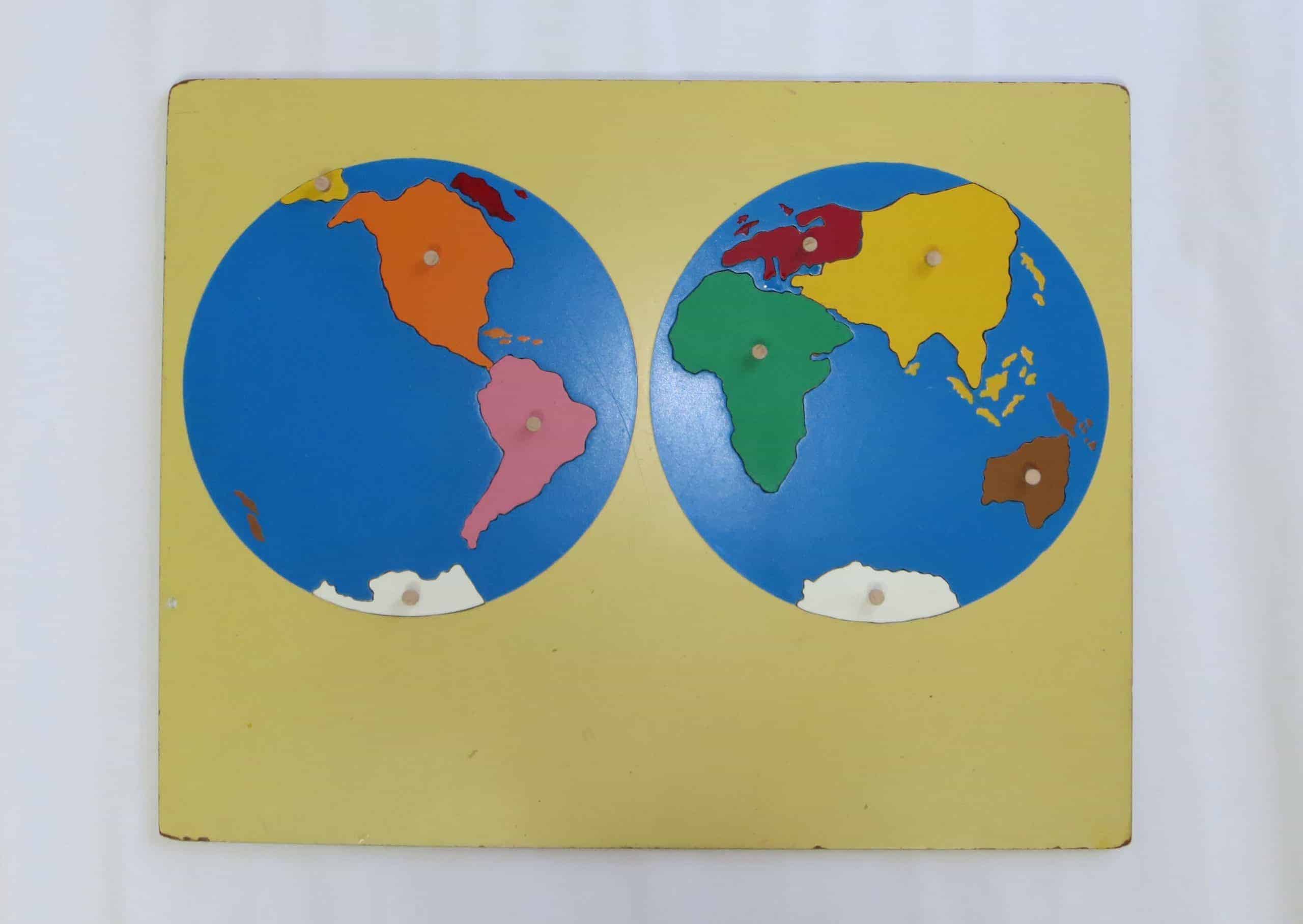
The Continents
Children work methodically with the continents puzzle map learning the names and beginning to recall the shapes of each one. They will move on to tracing each continent on paper (more fine motor skills at work) and may make small booklets of the individual tracings. They may colour the continents in their booklets. Later each continent name will be printed underneath. Some children also like to replicate the full size continents puzzle map on a large piece of paper. They will trace out each piece in its proper placement on two large circles representing the eastern and western hemispheres.
Countries of the World
As children progress from the continents geography maps, they will begin to explore the world around them. The next maps are typically North America, South America, Europe, Africa and Asia. Following that there are a multitude of more specialized maps to really drill down from whole countries, to provinces and states. A map of Australia will have all of their states and territories as individual pieces, similarly like a map of the United States. A map of Canada will have all the provinces and territories and so on.
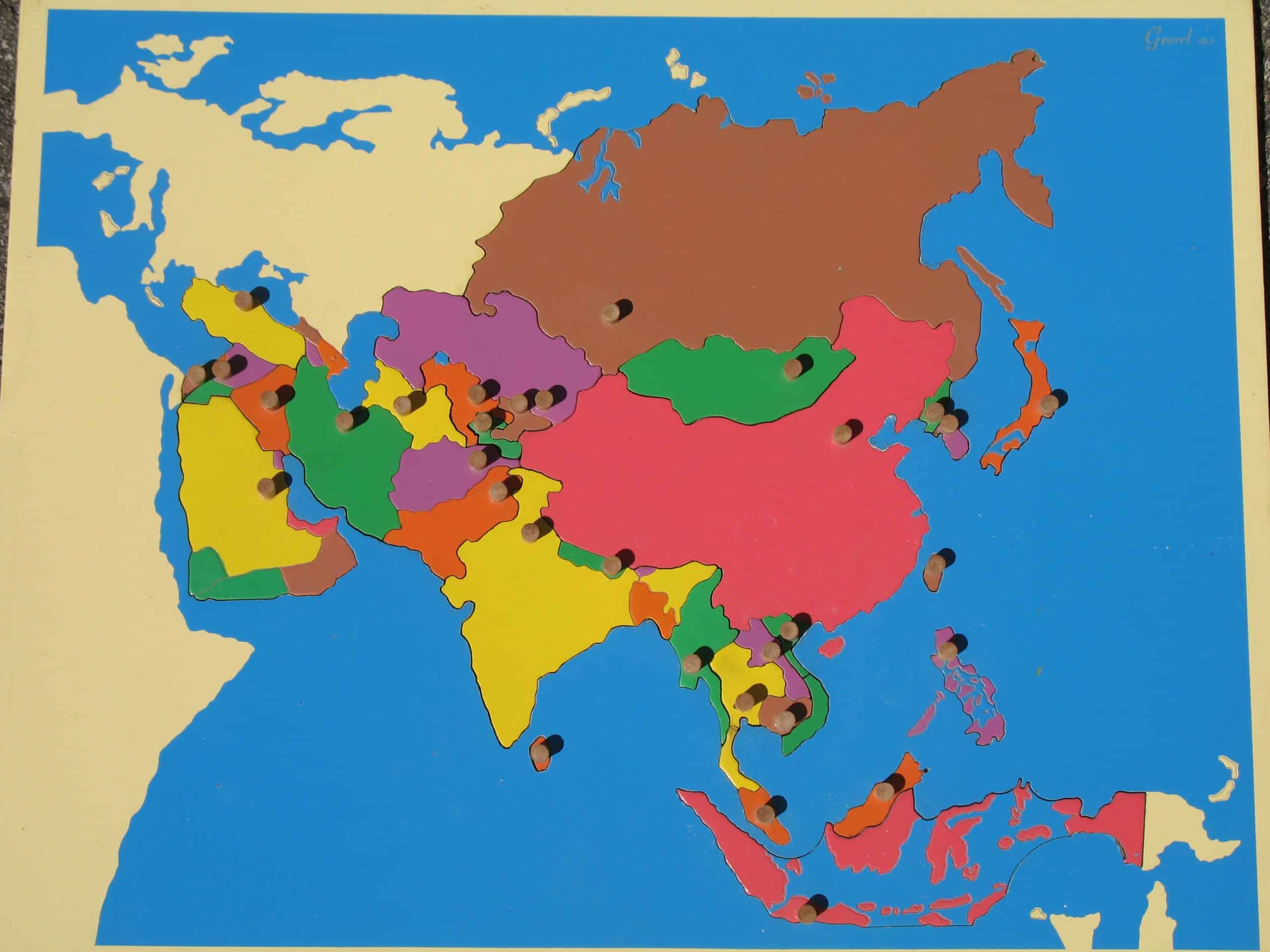
The geography maps are all used in the same manner by tracing the shapes and naming and printing them. As you can imagine, a puzzle map with all of the states of the United States is a substantial undertaking. The simultaneous joy and concentration resulting from the puzzle solving aspect of the activity engages learners on many levels.
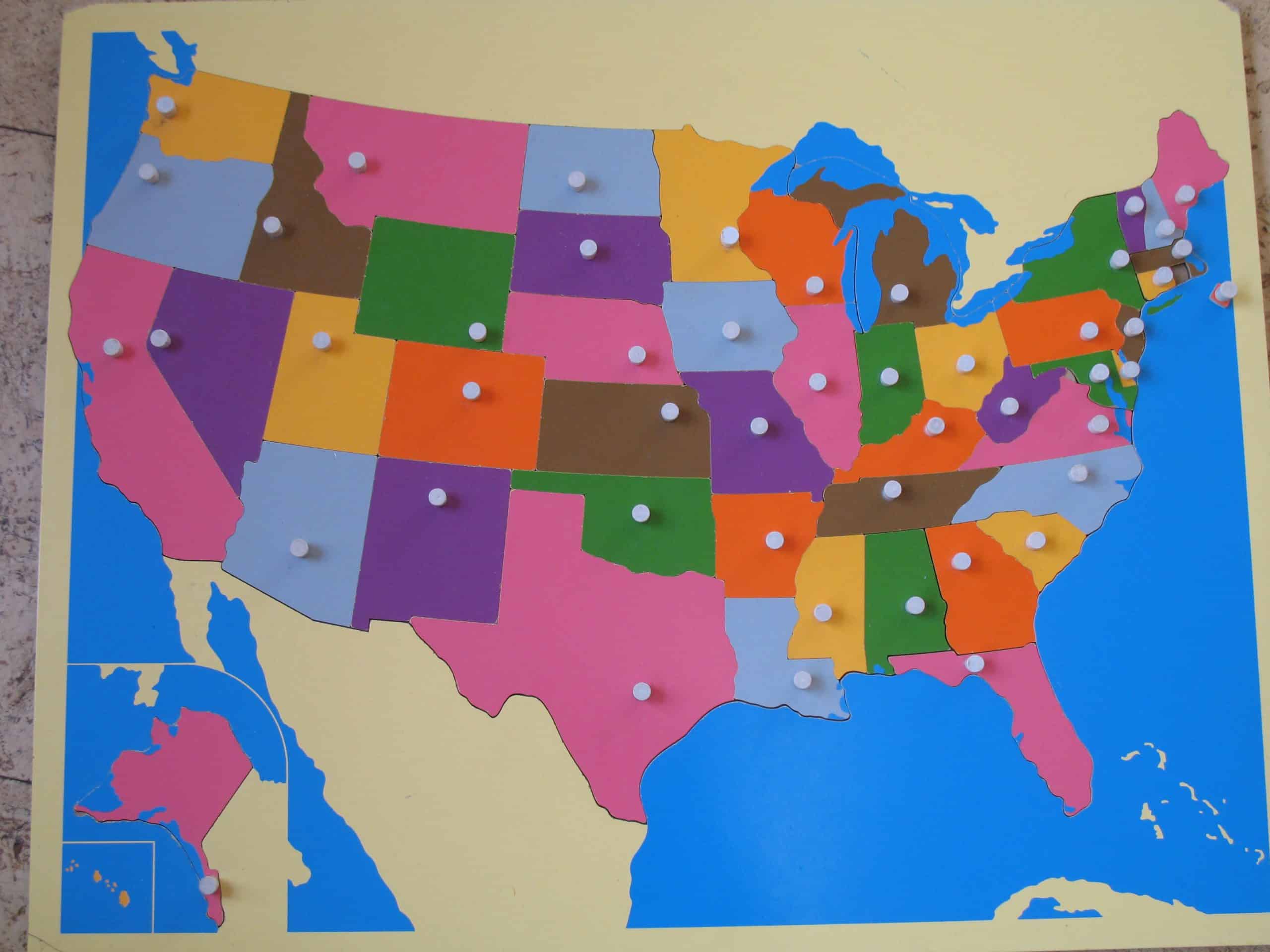
Learning with Puzzle Maps is Interactive
Dr. Maria Montessori took an idea of learning by way of puzzles to a very fine degree of pedagogy. She managed to weave it throughout the curriculum in an engaging and progressive way. Learning about countries becomes much more interactive and creative, when a child can manipulate the pieces, trace them, colour them and examine their shapes. This is much more engaging than just filling out the exact same worksheet that everyone else has in the class, wouldn’t you agree?
Oh, and by the way, perhaps the hidden educational jewel of the Montessori puzzle maps – the knobs are placed on the capital city of the country, province or state. Were you wondering why the knobs on some pieces are not in the center?!
